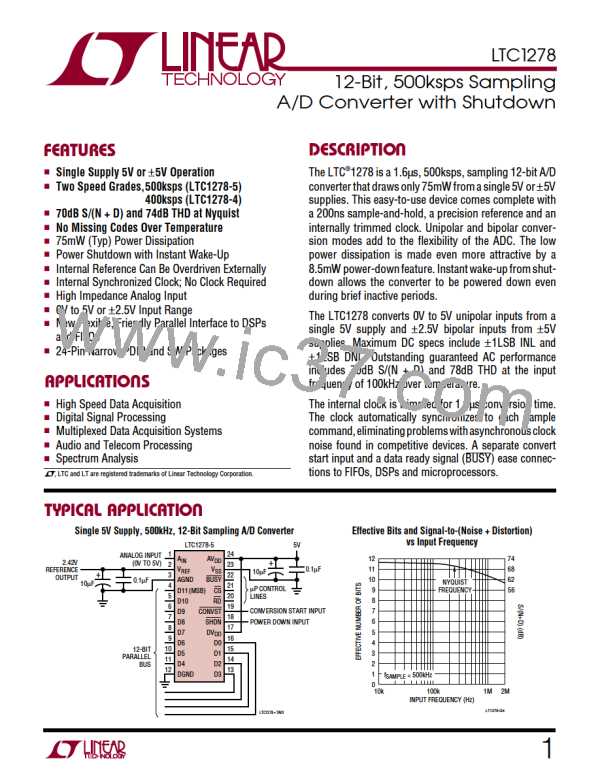LTC1278
U
W U U
APPLICATIONS INFORMATION
0
frequency is shown in Figure 4. The LTC1278 has good
distortion performance up to the Nyquist frequency and
beyond.
f
f
f
= 500kHz
= 96.80kHz
= 101.68kHz
SAMPLE
IN1
IN2
–20
–40
–60
0
f
= 500kHz
SAMPLE
–10
–20
–30
–40
–50
–60
–70
–80
–90
–100
–80
–100
–120
2ND HARMONIC
0
50k
100k
FREQUENCY (Hz)
150k
200k
250k
THD
LTC1278 G8
3RD HARMONIC
Figure 5. Intermodulation Distortion Plot
10k
100k
INPUT FREQUENCY (Hz)
1M 2M
LT1278 G6
Peak Harmonic or Spurious Noise
Figure 4. Distortion vs Input Frequency
The peak harmonic or spurious noise is the largest spec-
tral component excluding the input signal and DC. This
value is expressed in decibels relative to the RMS value of
a full-scale input signal.
Intermodulation Distortion
If the ADC input signal consists of more than one spectral
component, the ADC transfer function nonlinearity can
produce intermodulation distortion (IMD) in addition to
THD. IMD is the change in one sinusoidal input caused by
the presence of another sinusoidal input at a different
frequency.
Full Power and Full Linear Bandwidth
The full power bandwidth is that input frequency at which
the amplitude of the reconstructed fundamental is re-
duced by 3dB for a full-scale input signal.
The full linear bandwidth is the input frequency at which
the S/(N + D) has dropped to 68dB (11 effective bits). The
LTC1278 has been designed to optimize input bandwidth,
allowing ADC to undersample input signals with frequen-
cies above the converter’s Nyquist Frequency. The noise
floor stays very low at high frequencies; S/(N + D) be-
comes dominated by distortion at frequencies far beyond
Nyquist.
If two pure sine waves of frequencies fa and fb are applied
to the ADC input, nonlinearities in the ADC transfer func-
tion can create distortion products at sum and difference
frequencies of mfa ± nfb, where m and n = 0, 1, 2, 3, etc.
Forexample,the2ndorderIMDtermsinclude(fa+fb)and
(fa – fb) while the 3rd order IMD terms include (2fa + fb),
(2fa – fb), (fa + 2fb), and (fa – 2fb). If the two input sine
waves are equal in magnitude, the value (in decibels) of
the 2nd order IMD products can be expressed by the
following formula:
Driving the Analog Input
The analog input of the LTC1278 is easy to drive. It draws
only one small current spike while charging the sample-
and-hold capacitor at the end of conversion. During con-
version the analog input draws no current. The only
requirement is that the amplifier driving the analog input
must settle after the small current spike before the next
Amplitude at (fa ± fb)
IMD (fa ± fb) = 20log
Amplitude at fa
Figure 5 shows the IMD performance at a 100kHz input.
10

 Linear [ Linear ]
Linear [ Linear ]